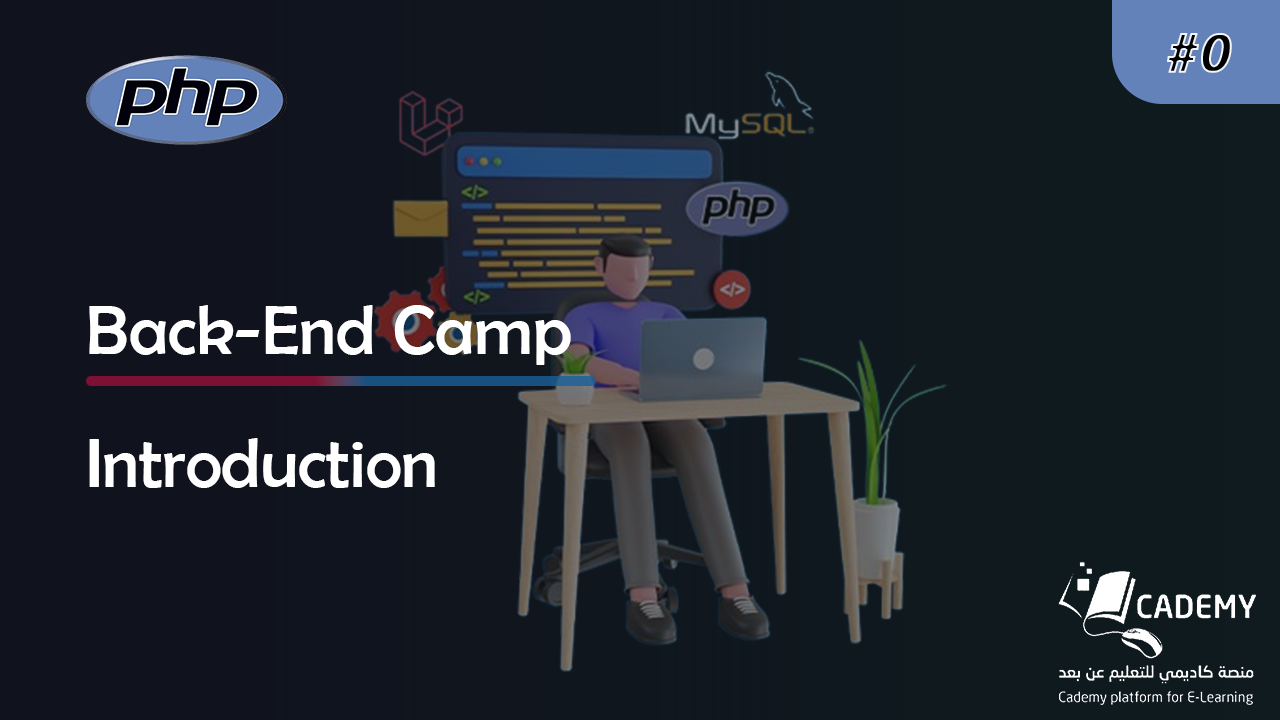Module 1: Introduction to Backend Development
1.1 Overview of Web Development
Understanding the Web Development Lifecycle
Frontend vs Backend: Roles and Responsibilities
Key Technologies in Web Development
The Role of a Backend Developer in Web Applications
1.2 Tools and Setup
Installing a Local Development Environment
XAMPP, WAMP, or MAMP
Setting Up Virtual Hosts
Introduction to Version Control with Git
Basic Git Commands
Using GitHub for Version Control
IDE and Text Editor Recommendations
Visual Studio Code, PhpStorm, Sublime Text
Module 2: Mastering PHP
2.1 PHP Basics
Introduction to PHP
History and Evolution of PHP
PHP Syntax and Tags
Variables and Data Types
Declaring and Using Variables
Data Types: Strings, Integers, Floats, Booleans, Arrays, Objects, NULL
Operators
Arithmetic, Assignment, Comparison, Increment/Decrement, Logical Operators
Control Structures
If-Else Statements
Switch Statements
Looping Structures: For, While, Do-While, Foreach
2.2 Functions and Arrays
Defining and Using Functions
Function Syntax
Passing Parameters and Return Values
Arrays
Indexed Arrays, Associative Arrays, Multidimensional Arrays
Array Functions: array_merge, array_diff, array_intersect, etc.
2.3 Advanced PHP
Object-Oriented Programming (OOP) in PHP
Classes and Objects
Properties and Methods
Inheritance and Polymorphism
Interfaces and Abstract Classes
Exception Handling
Try, Catch, Finally Blocks
Custom Exception Classes
PHP Sessions and Cookies
Managing User Sessions
Storing Data in Cookies
Module 3: Database Management with MySQL
3.1 Introduction to Databases
Understanding Relational Databases
Setting Up MySQL Server
Installing MySQL
Configuring MySQL Server
Using phpMyAdmin for Database Management
3.2 MySQL Basics
SQL Syntax and Commands
SELECT, INSERT, UPDATE, DELETE
Filtering Data with WHERE Clause
Sorting Data with ORDER BY
Limiting Results with LIMIT
Creating and Managing Databases and Tables
Creating Databases and Tables
Defining Columns and Data Types
Modifying Table Structure
3.3 Advanced MySQL
Joins
Inner Join, Left Join, Right Join, Full Join
Combining Data from Multiple Tables
Indexes
Creating and Using Indexes for Performance Optimization
Transactions
Understanding ACID Properties
Implementing Transactions with COMMIT and ROLLBACK
Stored Procedures and Triggers
Creating and Using Stored Procedures
Implementing Triggers for Automatic Actions
3.4 PHP and MySQL Integration
Connecting PHP to MySQL
Using MySQLi and PDO Extensions
Performing CRUD Operations
Creating, Reading, Updating, Deleting Records
Securing Database Interactions
Preventing SQL Injection
Using Prepared Statements
Module 4: Building Web Applications with Laravel
4.1 Introduction to Laravel
Overview of Laravel Framework
Features and Benefits
MVC Architecture
Setting Up a Laravel Project
Installing Laravel via Composer
Directory Structure and Configuration
4.2 Laravel Basics
Routing
Defining Routes in web.php
Using Route Parameters
Named Routes and Route Groups
Controllers
Creating Controllers
Controller Methods and Route Actions
Views
Blade Templating Engine
Using Blade Directives
Template Inheritance and Components
4.3 Database Operations with Eloquent ORM
Defining Models and Migrations
Creating Models
Running Migrations to Create Database Tables
Querying the Database with Eloquent
Retrieving Data: all(), find(), where()
Inserting, Updating, and Deleting Records
Relationships
Defining Relationships: One-to-One, One-to-Many, Many-to-Many
Eager Loading and Lazy Loading
4.4 Advanced Laravel
Middleware
Creating and Using Middleware
Middleware Parameters and Groups
Authentication
Implementing User Authentication
Registration, Login, and Logout
Authorization
Role-Based Access Control
Using Policies and Gates
Laravel’s Service Container
Understanding Dependency Injection
Service Providers and Facades
Module 5: Developing an E-Commerce Application (Amazon Clone)
5.1 Project Planning and Setup
Defining Project Scope and Requirements
Features and Functionality
User Roles and Permissions
Setting Up the Project Structure
Initializing a New Laravel Project
Configuring Environment Variables
5.2 User Authentication and Authorization
Implementing Registration and Login
User Registration Form
Login and Logout Functionality
Role-Based Access Control
Defining User Roles
Restricting Access to Certain Areas
5.3 Product Management
Creating Product Listings
Product Model and Migration
Product Controller and Views
Implementing Product Categories and Filters
Category Model and Migration
Filtering Products by Category
5.4 Shopping Cart and Checkout
Building a Shopping Cart System
Adding Products to Cart
Viewing and Updating Cart
Implementing Checkout and Payment Integration
Checkout Process
Integrating Payment Gateway (e.g., Stripe, PayPal)
5.5 Order Management
Handling Orders
Order Model and Migration
Order Controller and Views
User Purchase History
Displaying Order History for Users
Admin Panel for Managing Orders
Admin Dashboard
Managing Orders and Inventory
Module 6: Testing and Deployment
6.1 Testing Your Application
Writing Unit Tests
Creating Test Cases
Running Tests with PHPUnit
Feature Tests
Testing Application Features
Using Laravel’s Testing Helpers
Using Laravel Dusk for Browser Testing
Setting Up Laravel Dusk
Writing Browser Tests
6.2 Deployment
Preparing Your Application for Production
Configuring Environment Variables
Optimizing Performance (Caching, Minifying)
Deploying to a Web Server
Using DigitalOcean, AWS, or Other Hosting Providers
Setting Up SSL Certificates
Continuous Integration and Deployment
Using GitHub Actions, Travis CI, or Other CI/CD Tools
Module 7: Capstone Project
7.1 Project Planning
Choosing a Project Topic
Brainstorming Ideas
Defining Requirements and Scope
Defining Milestones and Deliverables
Creating a Project Timeline
Setting Achievable Goals
7.2 Project Development
Building the Application
Applying Concepts Learned in the Course
Using Best Practices and Coding Standards
Testing and Debugging
Ensuring Application Functionality
Fixing Bugs and Issues
7.3 Presentation and Review
Presenting the Project
Preparing a Presentation
Demonstrating Application Features
Peer Review and Feedback
Reviewing Projects of Other Students
Providing and Receiving Constructive Feedback
Additional Resources
Bonus Materials
Introduction to RESTful APIs with Laravel
Building and Consuming RESTful APIs
Authentication and Authorization in APIs
Advanced Security Practices
Protecting Against Common Security Threats
Implementing Security Best Practices
Performance Optimization Tips
Caching Strategies
Database Optimization
Course Features
Hands-On Projects
Real-World Examples and Applications
Building Practical Projects to Reinforce Learning
Interactive Quizzes and Assignments
Assessing Knowledge with Quizzes
Practical Assignments for Hands-On Experience
Community Support
Access to a Community of Learners and Instructors
Forums and Discussion Groups for Collaboration
Certification
Certificate of Completion
Recognizing Achievements and Skills Acquired

